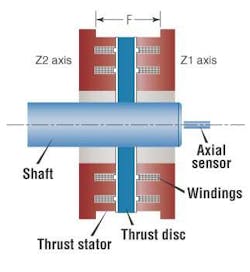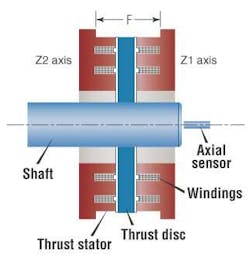Value of magnetic bearing solutions evident in compressor life-cycle costs
Tim Harris
Linda Widbro
Revolve Magnetic Bearings Inc.
Over the past decade, technical break-throughs have made many magnetic bearings economically feasible in industrial applications. Advanced software algorithms have also been developed to increase performance substantially.
Revolve Magnetic Bearings, a wholly owned subsidiary of SKF, develops and manufactures active magnetic bearing systems in which the bearings comprise electromagnets that control shaft motion through a variable magnetic field. A magnetic bearing system has three major parts:
- Bearing actuators
- Sensors
- Controllers and control algorithms.
A radial magnetic bearing is similar to an electric motor, but instead of torque, generates an attractive force to levitate and control the shaft. A typical radial stator consists of laminated actuators, each with two axes wound by coils. Electric current in the coil produces an attractive force on a ferro-magnetic rotor (laminated or solid). The air gap between the stator and the rotor is typically 0.5 to 2 mm.
For a magnetic thrust bearing, a solid steel disc is attached to the shaft with an annular stator on either side. The latter may have one or two windings to produce magnetic flux. The thrust stator can be solid or have laminated sections to increase the force response bandwidth. In machinery with modest thrust loads, the radial bearings can be replaced by conical bearings to control both radial and thrust motion.
Active magnetic bearings are based on attractive forces. Shaft position sensors are used to provide feedback to the control system. Typically, inductive sensors in five axes (four radial, one thrust) are employed. These sensors produce a linear output and have a wide temperature operating range.
Magnetic bearing currents are controlled and monitored via a controller, which uses control algorithms to vary the bearing forces in order to influence the shaft position. Controller hardware comprises in the main digital supply processor (DSP) electronics, power supply, and amplifiers.
The DSP electronics provide the "brains" behind a magnetic bearing system. Advanced control algorithms measure position and regulate the current to the actuators 10,000 times/sec. Machine-specific tuning parameters can be modified using SKF software called MBScope, which allows the user to monitor the bearing and performance through studying parameters such as vibration, balance, and speed.
SKF has also developed adaptive vibration control software, which controls the bearing's response to shaft unbalance. This can be used in two ways. One is to allow the shaft to rotate around its geometric center and control the shaft rigidly, to eliminate run-out caused by the unbalance. The other way is to rotate the shaft around its mass center to reduce the vibration transferred to the casing. The software can also facilitate insitu stiffness adjustment (inversion of position compliance) and damping of the magnetic bearings. This allows a machine to safely pass critical speeds and bend- ing modes.
Magnetic bearings do not require any lubricant. This makes magnetic bearings particularly suited to machines operating in a vacuum, at high or low (cryogenic) temperatures, or in corrosive process fluids. Lubrication-free operation also means that lubrication and auxiliary systems, such as pumps and filters, can be eliminated, with consequent reductions in cost.
null
Low shaft rotational losses are another characteristic of magnetic bearings. This allows motor power to be reduced, with higher efficiencies in turn. Low loss means that operating temperatures are generally lower than those in other bearings, such as rolling element or fluid film bearings, lessening the requirement for cooling equipment. Compared to these other types of bearings, magnetic bearings also allow much higher surface speeds – up to 250 m/s, or around 4.5 million 'n x d' (rotational speed in min-1 and diameter in mm.)
To realize the full value of a magnetic bearing solution in large turbo machine applications, it is essential to consider the system's life-cycle costs, i.e., maintenance costs, energy consumption, displaced system components, spare parts. Through use of a magnetic bearing system, the oil lubrication and cooling systems and condition monitoring equipment can all be eliminated, and the machinery's footprint can be decreased. The need for spare parts associated with the displaced equipment is therefore removed, while the reliability of the machinery is increased.
Compared with a system with oil-lubricated bearings, regular scheduled maintenance needs are lower, due to the removal of consumables and worn components. Auxiliary equipment is also dispensed with, reducing the number of potential failure points. Furthermore, as a magnetic bearing system rotates without contact, it consumes a fraction of the energy used by a hydrodynamic bearing system.
Oil-free operation is also an environmentally friendly solution and eliminates contamination of process equipment. This can lead to cost savings of nearly $100,000 a year for turbo-machinery above 1 MW, such as the natural gas compressor that SKF developed with Dresser Rand for the pipeline industry. The vision is to have high-speed motor compressor designs on a common shaft to simplify the machine as much as possible, in turn promoting reliable subsea compressor applications.
For more information, contact Linda Widbro, SKF's Magnetic Bearings Division. Tel: +1 403 232 9292, fax: +1 403 232 9255, [email protected], www.revolve.com.


